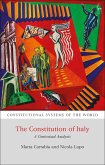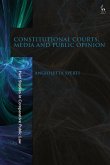Judge Marta Cartabia (Italy Bocconi University of Milan), Professor Nicola Lupo (Italy LUISS Guido Carli University)
The Constitution of Italy
A Contextual Analysis
Judge Marta Cartabia (Italy Bocconi University of Milan), Professor Nicola Lupo (Italy LUISS Guido Carli University)
The Constitution of Italy
A Contextual Analysis
- Gebundenes Buch
- Merkliste
- Auf die Merkliste
- Bewerten Bewerten
- Teilen
- Produkt teilen
- Produkterinnerung
- Produkterinnerung
This book introduces the reader to the Italian Constitution, which entered into force on 1 January 1948, and examines whether it has successfully managed the political and legal challenges that have occurred since its inception, and fulfilled the three main functions of a Constitution: maintaining a community, protecting the fundamental rights of citizens and ensuring the separation of powers.
Andere Kunden interessierten sich auch für
![The Constitution of Italy The Constitution of Italy]() Judge Marta Cartabia (Italy Bocconi University of Milan)The Constitution of Italy45,99 €
Judge Marta Cartabia (Italy Bocconi University of Milan)The Constitution of Italy45,99 €![Constitutional Courts, Media and Public Opinion Constitutional Courts, Media and Public Opinion]() Angioletta Sperti (Italy University of Pisa)Constitutional Courts, Media and Public Opinion139,99 €
Angioletta Sperti (Italy University of Pisa)Constitutional Courts, Media and Public Opinion139,99 €![Transitional Justice in Italy and the Crimes of Fascism and Nazism Transitional Justice in Italy and the Crimes of Fascism and Nazism]() Paolo CaroliTransitional Justice in Italy and the Crimes of Fascism and Nazism47,99 €
Paolo CaroliTransitional Justice in Italy and the Crimes of Fascism and Nazism47,99 €![Transitional Justice in Italy and the Crimes of Fascism and Nazism Transitional Justice in Italy and the Crimes of Fascism and Nazism]() Paolo CaroliTransitional Justice in Italy and the Crimes of Fascism and Nazism186,99 €
Paolo CaroliTransitional Justice in Italy and the Crimes of Fascism and Nazism186,99 €![Renewable Energy Law Renewable Energy Law]() Olivia Woolley (UK Durham University)Renewable Energy Law45,99 €
Olivia Woolley (UK Durham University)Renewable Energy Law45,99 €![The Harm in Hate Speech The Harm in Hate Speech]() Jeremy WaldronThe Harm in Hate Speech31,99 €
Jeremy WaldronThe Harm in Hate Speech31,99 €![Governmental and Intergovernmental Immunity in Australia and Canada Governmental and Intergovernmental Immunity in Australia and Canada]() Colin McNairnGovernmental and Intergovernmental Immunity in Australia and Canada36,99 €
Colin McNairnGovernmental and Intergovernmental Immunity in Australia and Canada36,99 €-
-
-
This book introduces the reader to the Italian Constitution, which entered into force on 1 January 1948, and examines whether it has successfully managed the political and legal challenges that have occurred since its inception, and fulfilled the three main functions of a Constitution: maintaining a community, protecting the fundamental rights of citizens and ensuring the separation of powers.
Produktdetails
- Produktdetails
- Constitutional Systems of the World
- Verlag: Bloomsbury Publishing PLC
- Seitenzahl: 288
- Erscheinungstermin: 10. Februar 2022
- Englisch
- Abmessung: 224mm x 146mm x 23mm
- Gewicht: 482g
- ISBN-13: 9781509905720
- ISBN-10: 1509905723
- Artikelnr.: 60601592
- Herstellerkennzeichnung
- Libri GmbH
- Europaallee 1
- 36244 Bad Hersfeld
- gpsr@libri.de
- Constitutional Systems of the World
- Verlag: Bloomsbury Publishing PLC
- Seitenzahl: 288
- Erscheinungstermin: 10. Februar 2022
- Englisch
- Abmessung: 224mm x 146mm x 23mm
- Gewicht: 482g
- ISBN-13: 9781509905720
- ISBN-10: 1509905723
- Artikelnr.: 60601592
- Herstellerkennzeichnung
- Libri GmbH
- Europaallee 1
- 36244 Bad Hersfeld
- gpsr@libri.de
Marta Cartabia is Professor in the Department of Law at Bocconi University of Milan, Italy, Nicola Lupo is Professor of Public Law at the LUISS Guido Carli University in Rome, Italy.
1. The Making of the Italian Constitution and its Evolution
I. Introduction
II. The Albertine Statute
III. The Fascist Regime, the Second World War and the Transition to the
Republic (1922-1945)
IV. The Constituent Assembly (1946-1948)
V. The Rigidity of the Republican Constitution
VI. Procedures for and Limits on Constitutional Amendments
VII. The Most Important Constitutional Amendments
VIII. The Evolution of the Italian Republican Constitution
IX. Conclusion
Further Reading
2. The Italian Constitution within the 'Composite' European Constitution
I. Introduction
II. Openness to the International Order and its Foundations
III. The Constitutional Principles on International Law
IV. The 'European Journey' of the Constitutional Court
V. The 'Counter-limits' Doctrine
VI. The European Convention of Human Rights in the Italian Legal System
VII. Constitutional Rules and Practice of Implementing EU Law
VIII. Conclusion
Further Reading
3. Popular Sovereignty and Separation of Powers
I. Introduction
II. The Democratic Principle in the Italian Constitution: The Right to Vote
and to be Elected
III. Direct Democracy: The Abrogative Referendum and its Different Usages
IV. Representative Democracy: The Electoral System and its Evolution
V. Conclusion
Further Reading
4. Parliament
I. Introduction
II. The Italian Parliament in the Constitution
III. A Symmetrical Bicameralism
IV. The Internal Organisation of the Chamber and the Senate
V. Privileges and Immunities of MPs
VI. Parliamentary Rules of Procedure
VII. The Legislative Process 2
VIII. The Budgetary Process
IX. The Oversight Function
X. Conclusion
Further Reading
5. The Government: Between Politics and Administration
I. Introduction
II. The Structure of the Government
III. The Confidence Relationship with the Two Houses of Parliament
IV. The Primary and Secondary Normative Powers of the Government
V. The Distinction between Politics and Administration
VI. The Constitutional Principles on Public Administration
VII. The Auxiliary Bodies and the Independent Authorities
VIII. Conclusion
Further Reading
6. The President of the Republic
I. Introduction
II. Election, Term of Office and Substitution
III. The Responsibility of the President of the Republic
IV. The Counter-signature and the Classification of the Acts of the
President of the Republic
V. The Shaping of the Role of the President of the Republic Throughout the
Constitutional Experience
VI. Conclusion
Further Reading
7. Regional and Local Government
I. Introduction
II. Origins and Evolution of the 'Republic of Autonomies'
III. The Constitutional Framework and its Delayed Implementation
IV. Special and Ordinary Regions
V. The Direct Election of the Presidents of the Regions and Statutory
Autonomy
VI. The Distribution of Legislative Competences between the State and
Regions
VII. Administrative Autonomy and the Principles of Subsidiarity and Loyal
Cooperation
VIII. Financial Autonomy
IX. Local Authorities
X. Conclusion
Further Reading
8. The Judiciary
I. Introduction
II. The Evolution of the Judicial Function
III. The Separation of Powers and Judicial Independence
IV. The Organisation of the Judiciary
V. Judicial Responsibility
VI. Conclusion
Further Reading
9. The Constitutional Court
I. Introduction
II. Historical Background
III. The European Model of Constitutional Adjudication
IV. The Constitutional Court: Composition and Functions
V. The Court's Delayed Establishment and First Years of Activity: Reviewing
Fascist Legislation
VI. A Variety of Remedies
VII. The Incidental Procedure and the Relationship with Ordinary Courts
VIII. The Constitutional Court and European Courts
IX. The Relational Character of Italian Constitutional Adjudication and
Internal Collegiality
X. Conclusion
Further Reading
10. Protection of Rights
I. Introduction
II. The Evolution of Constitutionalism and the 'Age of Rights'
III. Inviolable Rights
IV. The Italian Approach to Fundamental Rights: Personalism, Pluralism and
Solidarity
V. Codified Rights and New Rights
VI. Limiting Rights
VII. Judicial and Non-judicial Safeguards
VIII. Key Rights
IX. Conclusion
Further Reading
I. Introduction
II. The Albertine Statute
III. The Fascist Regime, the Second World War and the Transition to the
Republic (1922-1945)
IV. The Constituent Assembly (1946-1948)
V. The Rigidity of the Republican Constitution
VI. Procedures for and Limits on Constitutional Amendments
VII. The Most Important Constitutional Amendments
VIII. The Evolution of the Italian Republican Constitution
IX. Conclusion
Further Reading
2. The Italian Constitution within the 'Composite' European Constitution
I. Introduction
II. Openness to the International Order and its Foundations
III. The Constitutional Principles on International Law
IV. The 'European Journey' of the Constitutional Court
V. The 'Counter-limits' Doctrine
VI. The European Convention of Human Rights in the Italian Legal System
VII. Constitutional Rules and Practice of Implementing EU Law
VIII. Conclusion
Further Reading
3. Popular Sovereignty and Separation of Powers
I. Introduction
II. The Democratic Principle in the Italian Constitution: The Right to Vote
and to be Elected
III. Direct Democracy: The Abrogative Referendum and its Different Usages
IV. Representative Democracy: The Electoral System and its Evolution
V. Conclusion
Further Reading
4. Parliament
I. Introduction
II. The Italian Parliament in the Constitution
III. A Symmetrical Bicameralism
IV. The Internal Organisation of the Chamber and the Senate
V. Privileges and Immunities of MPs
VI. Parliamentary Rules of Procedure
VII. The Legislative Process 2
VIII. The Budgetary Process
IX. The Oversight Function
X. Conclusion
Further Reading
5. The Government: Between Politics and Administration
I. Introduction
II. The Structure of the Government
III. The Confidence Relationship with the Two Houses of Parliament
IV. The Primary and Secondary Normative Powers of the Government
V. The Distinction between Politics and Administration
VI. The Constitutional Principles on Public Administration
VII. The Auxiliary Bodies and the Independent Authorities
VIII. Conclusion
Further Reading
6. The President of the Republic
I. Introduction
II. Election, Term of Office and Substitution
III. The Responsibility of the President of the Republic
IV. The Counter-signature and the Classification of the Acts of the
President of the Republic
V. The Shaping of the Role of the President of the Republic Throughout the
Constitutional Experience
VI. Conclusion
Further Reading
7. Regional and Local Government
I. Introduction
II. Origins and Evolution of the 'Republic of Autonomies'
III. The Constitutional Framework and its Delayed Implementation
IV. Special and Ordinary Regions
V. The Direct Election of the Presidents of the Regions and Statutory
Autonomy
VI. The Distribution of Legislative Competences between the State and
Regions
VII. Administrative Autonomy and the Principles of Subsidiarity and Loyal
Cooperation
VIII. Financial Autonomy
IX. Local Authorities
X. Conclusion
Further Reading
8. The Judiciary
I. Introduction
II. The Evolution of the Judicial Function
III. The Separation of Powers and Judicial Independence
IV. The Organisation of the Judiciary
V. Judicial Responsibility
VI. Conclusion
Further Reading
9. The Constitutional Court
I. Introduction
II. Historical Background
III. The European Model of Constitutional Adjudication
IV. The Constitutional Court: Composition and Functions
V. The Court's Delayed Establishment and First Years of Activity: Reviewing
Fascist Legislation
VI. A Variety of Remedies
VII. The Incidental Procedure and the Relationship with Ordinary Courts
VIII. The Constitutional Court and European Courts
IX. The Relational Character of Italian Constitutional Adjudication and
Internal Collegiality
X. Conclusion
Further Reading
10. Protection of Rights
I. Introduction
II. The Evolution of Constitutionalism and the 'Age of Rights'
III. Inviolable Rights
IV. The Italian Approach to Fundamental Rights: Personalism, Pluralism and
Solidarity
V. Codified Rights and New Rights
VI. Limiting Rights
VII. Judicial and Non-judicial Safeguards
VIII. Key Rights
IX. Conclusion
Further Reading
1. The Making of the Italian Constitution and its Evolution
I. Introduction
II. The Albertine Statute
III. The Fascist Regime, the Second World War and the Transition to the
Republic (1922-1945)
IV. The Constituent Assembly (1946-1948)
V. The Rigidity of the Republican Constitution
VI. Procedures for and Limits on Constitutional Amendments
VII. The Most Important Constitutional Amendments
VIII. The Evolution of the Italian Republican Constitution
IX. Conclusion
Further Reading
2. The Italian Constitution within the 'Composite' European Constitution
I. Introduction
II. Openness to the International Order and its Foundations
III. The Constitutional Principles on International Law
IV. The 'European Journey' of the Constitutional Court
V. The 'Counter-limits' Doctrine
VI. The European Convention of Human Rights in the Italian Legal System
VII. Constitutional Rules and Practice of Implementing EU Law
VIII. Conclusion
Further Reading
3. Popular Sovereignty and Separation of Powers
I. Introduction
II. The Democratic Principle in the Italian Constitution: The Right to Vote
and to be Elected
III. Direct Democracy: The Abrogative Referendum and its Different Usages
IV. Representative Democracy: The Electoral System and its Evolution
V. Conclusion
Further Reading
4. Parliament
I. Introduction
II. The Italian Parliament in the Constitution
III. A Symmetrical Bicameralism
IV. The Internal Organisation of the Chamber and the Senate
V. Privileges and Immunities of MPs
VI. Parliamentary Rules of Procedure
VII. The Legislative Process 2
VIII. The Budgetary Process
IX. The Oversight Function
X. Conclusion
Further Reading
5. The Government: Between Politics and Administration
I. Introduction
II. The Structure of the Government
III. The Confidence Relationship with the Two Houses of Parliament
IV. The Primary and Secondary Normative Powers of the Government
V. The Distinction between Politics and Administration
VI. The Constitutional Principles on Public Administration
VII. The Auxiliary Bodies and the Independent Authorities
VIII. Conclusion
Further Reading
6. The President of the Republic
I. Introduction
II. Election, Term of Office and Substitution
III. The Responsibility of the President of the Republic
IV. The Counter-signature and the Classification of the Acts of the
President of the Republic
V. The Shaping of the Role of the President of the Republic Throughout the
Constitutional Experience
VI. Conclusion
Further Reading
7. Regional and Local Government
I. Introduction
II. Origins and Evolution of the 'Republic of Autonomies'
III. The Constitutional Framework and its Delayed Implementation
IV. Special and Ordinary Regions
V. The Direct Election of the Presidents of the Regions and Statutory
Autonomy
VI. The Distribution of Legislative Competences between the State and
Regions
VII. Administrative Autonomy and the Principles of Subsidiarity and Loyal
Cooperation
VIII. Financial Autonomy
IX. Local Authorities
X. Conclusion
Further Reading
8. The Judiciary
I. Introduction
II. The Evolution of the Judicial Function
III. The Separation of Powers and Judicial Independence
IV. The Organisation of the Judiciary
V. Judicial Responsibility
VI. Conclusion
Further Reading
9. The Constitutional Court
I. Introduction
II. Historical Background
III. The European Model of Constitutional Adjudication
IV. The Constitutional Court: Composition and Functions
V. The Court's Delayed Establishment and First Years of Activity: Reviewing
Fascist Legislation
VI. A Variety of Remedies
VII. The Incidental Procedure and the Relationship with Ordinary Courts
VIII. The Constitutional Court and European Courts
IX. The Relational Character of Italian Constitutional Adjudication and
Internal Collegiality
X. Conclusion
Further Reading
10. Protection of Rights
I. Introduction
II. The Evolution of Constitutionalism and the 'Age of Rights'
III. Inviolable Rights
IV. The Italian Approach to Fundamental Rights: Personalism, Pluralism and
Solidarity
V. Codified Rights and New Rights
VI. Limiting Rights
VII. Judicial and Non-judicial Safeguards
VIII. Key Rights
IX. Conclusion
Further Reading
I. Introduction
II. The Albertine Statute
III. The Fascist Regime, the Second World War and the Transition to the
Republic (1922-1945)
IV. The Constituent Assembly (1946-1948)
V. The Rigidity of the Republican Constitution
VI. Procedures for and Limits on Constitutional Amendments
VII. The Most Important Constitutional Amendments
VIII. The Evolution of the Italian Republican Constitution
IX. Conclusion
Further Reading
2. The Italian Constitution within the 'Composite' European Constitution
I. Introduction
II. Openness to the International Order and its Foundations
III. The Constitutional Principles on International Law
IV. The 'European Journey' of the Constitutional Court
V. The 'Counter-limits' Doctrine
VI. The European Convention of Human Rights in the Italian Legal System
VII. Constitutional Rules and Practice of Implementing EU Law
VIII. Conclusion
Further Reading
3. Popular Sovereignty and Separation of Powers
I. Introduction
II. The Democratic Principle in the Italian Constitution: The Right to Vote
and to be Elected
III. Direct Democracy: The Abrogative Referendum and its Different Usages
IV. Representative Democracy: The Electoral System and its Evolution
V. Conclusion
Further Reading
4. Parliament
I. Introduction
II. The Italian Parliament in the Constitution
III. A Symmetrical Bicameralism
IV. The Internal Organisation of the Chamber and the Senate
V. Privileges and Immunities of MPs
VI. Parliamentary Rules of Procedure
VII. The Legislative Process 2
VIII. The Budgetary Process
IX. The Oversight Function
X. Conclusion
Further Reading
5. The Government: Between Politics and Administration
I. Introduction
II. The Structure of the Government
III. The Confidence Relationship with the Two Houses of Parliament
IV. The Primary and Secondary Normative Powers of the Government
V. The Distinction between Politics and Administration
VI. The Constitutional Principles on Public Administration
VII. The Auxiliary Bodies and the Independent Authorities
VIII. Conclusion
Further Reading
6. The President of the Republic
I. Introduction
II. Election, Term of Office and Substitution
III. The Responsibility of the President of the Republic
IV. The Counter-signature and the Classification of the Acts of the
President of the Republic
V. The Shaping of the Role of the President of the Republic Throughout the
Constitutional Experience
VI. Conclusion
Further Reading
7. Regional and Local Government
I. Introduction
II. Origins and Evolution of the 'Republic of Autonomies'
III. The Constitutional Framework and its Delayed Implementation
IV. Special and Ordinary Regions
V. The Direct Election of the Presidents of the Regions and Statutory
Autonomy
VI. The Distribution of Legislative Competences between the State and
Regions
VII. Administrative Autonomy and the Principles of Subsidiarity and Loyal
Cooperation
VIII. Financial Autonomy
IX. Local Authorities
X. Conclusion
Further Reading
8. The Judiciary
I. Introduction
II. The Evolution of the Judicial Function
III. The Separation of Powers and Judicial Independence
IV. The Organisation of the Judiciary
V. Judicial Responsibility
VI. Conclusion
Further Reading
9. The Constitutional Court
I. Introduction
II. Historical Background
III. The European Model of Constitutional Adjudication
IV. The Constitutional Court: Composition and Functions
V. The Court's Delayed Establishment and First Years of Activity: Reviewing
Fascist Legislation
VI. A Variety of Remedies
VII. The Incidental Procedure and the Relationship with Ordinary Courts
VIII. The Constitutional Court and European Courts
IX. The Relational Character of Italian Constitutional Adjudication and
Internal Collegiality
X. Conclusion
Further Reading
10. Protection of Rights
I. Introduction
II. The Evolution of Constitutionalism and the 'Age of Rights'
III. Inviolable Rights
IV. The Italian Approach to Fundamental Rights: Personalism, Pluralism and
Solidarity
V. Codified Rights and New Rights
VI. Limiting Rights
VII. Judicial and Non-judicial Safeguards
VIII. Key Rights
IX. Conclusion
Further Reading








